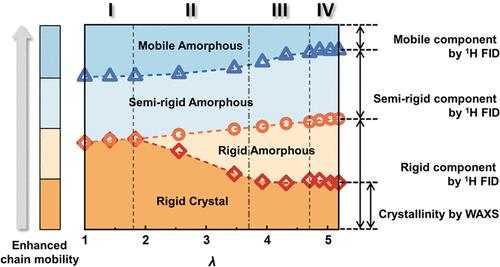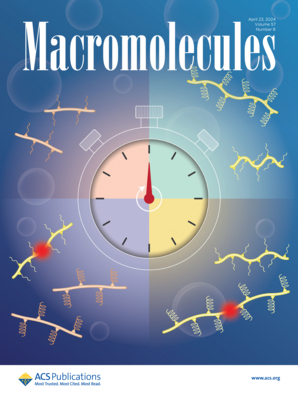Strain-Dependent Evolution of the Rigid Amorphous Fraction of Low-Density Polyethylene under Deformation
IF 5.1
1区 化学
Q1 POLYMER SCIENCE
引用次数: 0
Abstract
Understanding the deformation mechanism of the amorphous phase in semicrystalline polymers has been challenging due to the lack of a long-range ordered structure and chain dynamics heterogeneity. In this study, the amorphous chains’ reorientation and dynamics change under uniaxial elongation of low-density polyethylene (LDPE) was investigated, utilizing 1H time-domain nuclear magnetic resonance (1H TD-NMR) in combination with wide-angle X-ray scattering (WAXS). Depending on the chain dynamics difference, the amorphous phase can be decomposed into semirigid and mobile amorphous fractions, where the third rigid amorphous fraction appears under deformation. Such a rigid amorphous fraction, which is generated during necking (1.8 < λ < 4.7), shows much slower dynamics (similar T2 as the crystalline phase) as compared with the other two amorphous fractions. Moreover, strain-dependent 1H TD-NMR and WAXS results clarify different structural transformation pathways for the rigid amorphous fraction. During the stress-softening (region II, 1.8 < λ < 3.7), accompanied by decreasing crystallinity from 0.35 to 0.20 by WAXS, the rigid amorphous fraction is constantly formed (from 0 to 0.20), mainly at the compensation of the crystalline phase by lamellar fragmentation; and in the stress plateau (region III, 3.7 < λ < 4.7) with constant crystallinity at 0.20, elongated and tightly packed semirigid amorphous chains are the main source of the rigid amorphous fraction (from 0.20 to 0.25). The rigid amorphous fraction generated by the former pathway exhibits more constrained chain mobility. The strain-dependent evolution of the rigid amorphous fraction is further supported by in situ 1H TD-NMR results in addition to the ex situ process. Current work demonstrates 1H TD-NMR as a promising technique for elucidating the amorphous chain reorientation and dynamics change upon deformation.

求助全文
约1分钟内获得全文
求助全文
来源期刊

Macromolecules
工程技术-高分子科学
CiteScore
9.30
自引率
16.40%
发文量
942
审稿时长
2 months
期刊介绍:
Macromolecules publishes original, fundamental, and impactful research on all aspects of polymer science. Topics of interest include synthesis (e.g., controlled polymerizations, polymerization catalysis, post polymerization modification, new monomer structures and polymer architectures, and polymerization mechanisms/kinetics analysis); phase behavior, thermodynamics, dynamic, and ordering/disordering phenomena (e.g., self-assembly, gelation, crystallization, solution/melt/solid-state characteristics); structure and properties (e.g., mechanical and rheological properties, surface/interfacial characteristics, electronic and transport properties); new state of the art characterization (e.g., spectroscopy, scattering, microscopy, rheology), simulation (e.g., Monte Carlo, molecular dynamics, multi-scale/coarse-grained modeling), and theoretical methods. Renewable/sustainable polymers, polymer networks, responsive polymers, electro-, magneto- and opto-active macromolecules, inorganic polymers, charge-transporting polymers (ion-containing, semiconducting, and conducting), nanostructured polymers, and polymer composites are also of interest. Typical papers published in Macromolecules showcase important and innovative concepts, experimental methods/observations, and theoretical/computational approaches that demonstrate a fundamental advance in the understanding of polymers.
 求助内容:
求助内容: 应助结果提醒方式:
应助结果提醒方式:


